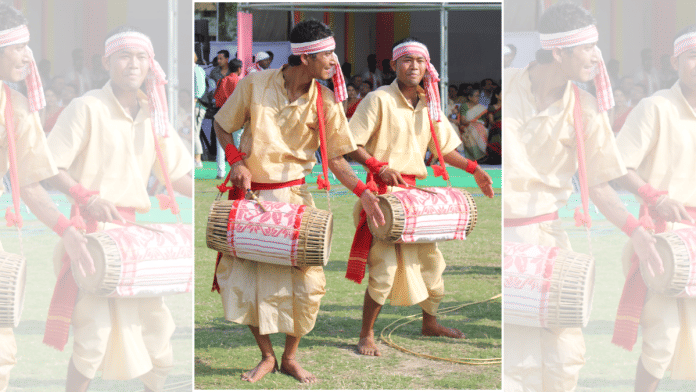Thank you dear subscribers, we are overwhelmed with your response.
Your Turn is a unique section from ThePrint featuring points of view from its subscribers. If you are a subscriber, have a point of view, please send it to us. If not, do subscribe here: https://theprint.in/subscribe/
There was a time when the deep, rolling beat of the bor dhol could summon an entire village in Assam. Before microphones, LED lights, and DJ systems, it was this drum — the heart of the Dhulia tradition, that carried news, stories, laughter, and protest across the plains. When a Dhulia troupe arrived, children perched on fences, elders leaned on walking sticks, and soon the air filled with rhythm, song, and satire. For a few hours, the village became one living, breathing audience.
That sound is fading. Drumming machines are replacing them. The Dhulia tradition, a dazzling blend of drumming, dance, acting, myth, and mimicry, is slipping away from Assam’s collective memory. What was once the voice of the people now struggles to be heard amid the noise of modern entertainment and neglect.
For centuries, the Kamrupi Dhulia or Bor Dhulia has been much more than a performer. He was a messenger, philosopher, and jester rolled into one. With the bor dhol slung over his shoulder, he could summon gods, mock leaders, narrate epics, or poke fun at human folly, all in a single performance. His art carried rhythm, resistance, and reverence. Through masks, mimicry, and improvised dialogue, the Dhulia turned open courtyards into spaces of reflection, humour, and joy.
Today, those spaces are shrinking. The younger generation rarely attends a Dhulia performance, many have never even seen one. Television, mobile phones, and the endless scroll of digital media have changed what people watch and how they watch it. A Dhulia’s long storytelling arcs and subtle humour compete poorly with the instant gratification of reels and reality shows. The result: an ancient art gasping for air in its own homeland.
The decline of Dhulia culture is not only cultural but economic. Most performers come from working-class backgrounds, depending on seasonal festivals for meagre income. A troupe may earn a few hundred or a thousand rupees after an all-night show, hardly enough to sustain a family. Costumes, drums, and travel expenses swallow much of their earnings. With no steady income or institutional support, many younger artists abandon the craft, seeking work in cities or other trades.
The few remaining masters, now in their sixties or seventies, carry centuries of memory in their hands. When they go, so will the unwritten songs, the improvised verses, and the gestures only time can teach. Their art is not just disappearing — it is aging out of existence.
This loss, however, is not inevitable. It stems from apathy, from audiences, institutions, and policymakers alike. Cultural preservation in Assam often stops at token gestures during major festivals. Occasional financial aid or festival appearances help for a season, not for a generation.
A true revival needs vision and structure. Dhulia must be integrated into Assam’s cultural policy, with training centres, apprenticeships, and scholarships that nurture new talent. Folk performers deserve pensions, healthcare, and insurance, just like classical artists or athletes. Their instruments and costumes should be subsidised; their performances documented and archived. Schools and universities can host workshops so students can experience the rhythm and meaning of Dhulia firsthand.
Yet preservation should not mean sanitization. The Dhulia’s power lies in its rawness, its earthy humour, social satire, and emotional honesty. When folk art is repackaged for tourists or shortened for stage shows, it often loses its heart. The goal should not be to make Dhulia “modern” but to make it visible and valued for what it is — a living, breathing art of the people.
There are small sparks of hope. In parts of Barpeta and Bajali, Durga Puja and Kali Puja committees are once again inviting Dhulia troupes alongside DJs and pop singers. Videos of performances circulate on social media, bringing the sound of the bor dhol to new ears. A few young artists are experimenting with adaptations that honour, not dilute, tradition.
But hope alone is not enough. Without sustained support, Dhulia will become a nostalgic memory, a line in a heritage brochure rather than a living art form. To lose it would be to lose more than music; it would mean losing a voice that once spoke for the voiceless.
When the bor dhol beats, it does more than make music, it reminds a people of who they are. Assam still has time to listen before that sound fades into silence.
These pieces are being published as they have been received – they have not been edited/fact-checked by ThePrint.


